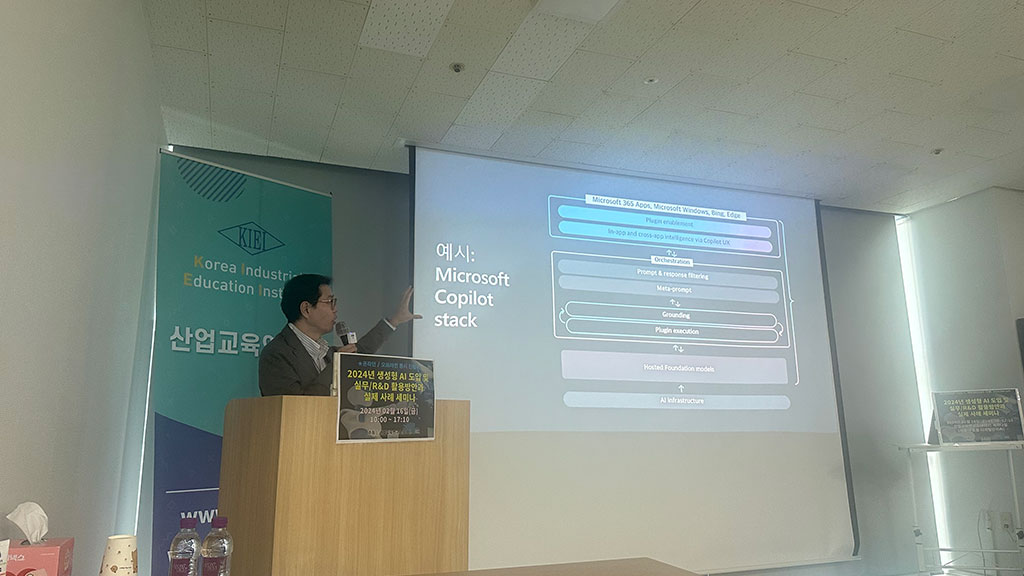KIEI 산업교육연구소가 16일 ‘2024년 생성형 AI 도입 및 실무/R&D 활용방안과 실제 사례 세미나’를 개최했다. 세미나에서는 △생성 AI 동향과 기업의 도입 전략 △분야별 생성형 AI 활용방안 및 사례 △생성형 AI 보안 전략 등을 다뤘다.
▲이건복 MS 디벨로퍼 리더
경제성·고성능 요구…AI 경량화 치열
MS, 엣지 적용 SLM 모델 Phi-2 제공
다양한 분야의 R&D에서 생성형 AI 기술이 대중화되고 있다. 디지털 전환을 넘어 AX 시대에는 LLM과 SLM를 혼합하여 사용하는 시나리오의 확보가 중요해질 것으로 전망된다.
KIEI 산업교육연구소가 16일 ‘2024년 생성형 AI 도입 및 실무/R&D 활용방안과 실제 사례 세미나’를 개최했다. 세미나에서는 △생성 AI 동향과 기업의 도입 전략 △분야별 생성형 AI 활용방안 및 사례 △생성형 AI 보안 전략 등을 다뤘다.
챗GPT, 제미나이, 코파일럿, 라마2 등과 같은 LLM(대형언어모델)은 음악, 영상, 헬스케어, 신약 개발, 건설, 에너지 관리 등 다양한 분야에서 효용성이 증명돼 산업 전반에 걸쳐 AI 서비스 활용 확산 경쟁이 본격화됐다.
특히 최근 ‘멀티모달 AI(Multi-Modal AI)’로 텍스트·이미지·오디오·영상 등 다양한 형태의 데이터를 동시에 처리해 검색 도구부터 콘텐츠 제작에서 영향을 미칠 것으로 예측된다. 예컨대 오픈AI가 발표한 ‘소라’는 텍스트 기반 영상 제작 플랫폼이다. 사용자는 이를 통해 쉽게 프롬프트를 이해 및 해석하고 특정 캐릭터, 행동, 배경 등의 장면을 생성할 수 있다. 이제 정보의 단순한 나열보다 AI와 인간의 상호작용을 기반으로 한 작업으로 고객은 쉽게 맞춤형 콘텐츠를 접할 수 있게 됐다.
마이크로소프트는 AI 도구인 ‘코파일럿(Microsoft Copilot)’의 비전을 구체화하고 발전시켰다. 다양한 분야에서 업무 생산성과 비즈니스 프로세스를 혁신하기 위해 솔루션 전반에 도입하고 있다. MS에 따르면 PPT, 워드 등 문서 작업, 코딩을 지원하는 AI 에이전트를 통해 이용자의 만족도가 70%가 상승한 것으로 나타났다.
‘RAG(Retrieval Augmented Generation)’은 검색 기반 생성 모델을 뜻하며, 검색 엔진과 생성 모델을 결합해 많은 양의 사용자 데이터를 연결하는 기술이다. 이건복 MS 디벨로퍼 리더는 “아직 GPT5에 대한 내용은 구체적이지 않은 단계지만, 점차 단순하게 GPT 기능 하나만 쓰는 것이 아니라 다양한 LLM을 함께 사용하는 서비스 형태로 발전하고 있다”고 말했다.
최근에는 초거대 AI의 막대한 운영 비용과 전력소모 등의 문제를 보완하기 위한 AI 경량화가 주목받고 있다. ‘SLM(소형 언어 모델, Small Language Model)’은 경제성과 고성능을 갖춘 언어 모델로, 엣지 단에서 특수 영역에서 명령을 수행하는 역할로써 활용성이 더욱 확대될 것으로 기대된다.
SLM은 ‘온디바이스AI’로 스마트폰 등 특정 디바이스에 탑재되는 형태로 활용된다. 수십억 개의 파라미터(Parameter)로 이뤄지며, 학습에 필요한 시간과 자원을 적게 소모해 모바일 기기에서도 쉽게 실행 가능하기 때문이다. 또한 인터넷이 지원되지 않는 오프라인 상태에서도 사용 가능하고, 선별된 고품질 학습 데이터를 사용해 정확도가 높다.
예컨대 오프라인 환경에서 키오스크에 AI 기능이 탑재될 경우, LLM이 아닌 SLM으로 적용될 수 있다. 이건복 리더는 “SLM이 나와도 LLM은 필요하며, 모델의 혼합적인 사용이 일반화될 것”으로 전망했다. 구글은 제미나이 나노, MS는 Phi-2라는 오픈소스 모델을 제공하고 있다. Phi-2는 27억개의 매개변수를 가지며 코딩, 텍스트 등 작업을 LLM보다 빠르게 제공할 수 있다.
한편 이날 강의에서는 다양한 생성형 AI의 도입 및 R&D 활용 사례가 소개됐다. 허남구 에임드바이오 대표는 AI를 활용한 신약 개발은 어렵지만 3-5년 내 빅테크 기업의 투자 기반으로 성장을 전망했다. 허 대표는 “현재는 AI 신약 개발사의 성능 평가를 위해 검증 데이터가 부족한 한계가 존재하지만, 딥러닝 기반의 항체, 단백질 예측 등이 기대되고 있다”며, “논문을 기반으로 합성 신약 부분의 고성장이 기대된다”고 말했다.
또한 문현준 단국대 교수는 AI 기반 건물 에너지 및 실내환경 관리가 가능해진다고 주장했다. 건물설비 특성에 따라 에너지 관리 방안이 다르며, 학교, 소방서 등 건물 데이터를 기반으로 AI는 에너지 절감을 달성할 수 있다. 예컨대 구글은 딥마인드의 심층 신경 네트워크에 센서 냉각시스템의 데이터를 통해 딥러닝 과정에서 에너지 사용을 최소화 하면서 데이터센터의 냉방비용을 30% 절감했다.
